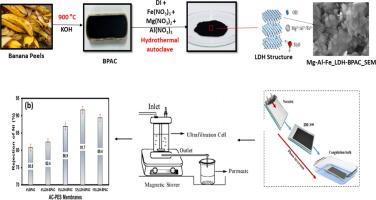Enhancing heavy metals filtration: Synergistic effects of banana peel-derived activated carbon and layered double hydroxides in ultrafiltration membranes
IF 8.1
1区 工程技术
Q1 ENGINEERING, CHEMICAL
引用次数: 0
Abstract
This study presents a novel approach for enhancing the performance of ultrafiltration (UF) membranes in removing heavy metals from wastewater by incorporating banana peel-derived activated carbon (BPAC) and ternary layered double hydroxides (LDH) into a polyethersulfone (PES) matrix. BPAC was synthesized via pyrolysis and fused into the polymeric matrix using the phase inversion technique. The developed PES-BPAC membranes exhibited higher permeability and maximum rejection compared to control membranes, attributed to the highly porous nature of BPAC. Further functionalization of the PES-BPAC membrane with Mg-Al-Fe-LDH at concentrations ranging from 4 to 16 % resulted in superior performance, with the 12 %LDH-BPAC membrane exhibiting the highest water flux of 354.6 LMH and 91.7 % rejection of Ni2+ ions. The superior composite membrane was tested in cross-flow and dead-end filtration and electrically regenerated to ensure long-term applicability. Comparative analysis with existing membranes and regeneration ability confirmed the commercial potential of the developed membranes for effective heavy metal removal from wastewater streams. This study highlights the synergistic effects of BPAC and LDH in enhancing UF membrane performance, providing an innovative and sustainable approach to wastewater treatment and biomass waste management.

求助全文
约1分钟内获得全文
求助全文
来源期刊

Separation and Purification Technology
工程技术-工程:化工
CiteScore
14.00
自引率
12.80%
发文量
2347
审稿时长
43 days
期刊介绍:
Separation and Purification Technology is a premier journal committed to sharing innovative methods for separation and purification in chemical and environmental engineering, encompassing both homogeneous solutions and heterogeneous mixtures. Our scope includes the separation and/or purification of liquids, vapors, and gases, as well as carbon capture and separation techniques. However, it's important to note that methods solely intended for analytical purposes are not within the scope of the journal. Additionally, disciplines such as soil science, polymer science, and metallurgy fall outside the purview of Separation and Purification Technology. Join us in advancing the field of separation and purification methods for sustainable solutions in chemical and environmental engineering.
 求助内容:
求助内容: 应助结果提醒方式:
应助结果提醒方式:


